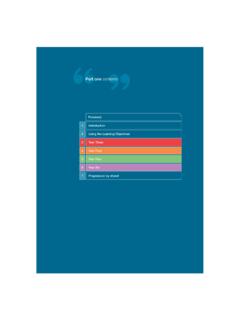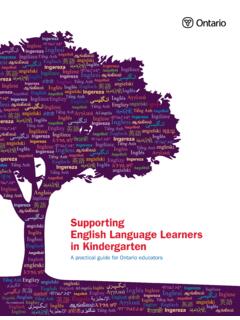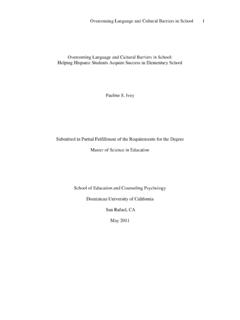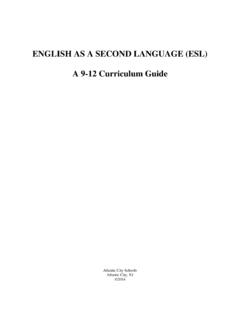Transcription of Developing language in the primary school: Literacy and ...
1 Developing language in the primary school : Literacy and primary languagesDeveloping language in the primary school : Literacy and primary languagesFirst published in 2009 Ref: 00482-2009 DWO-EN-01 DisclaimerThe Department for Children, Schools and Families wishes to make it clear that the Department and its agents accept no responsibility for the actual content of any materials suggested as information sources in this publication, whether these are in the form of printed publications or on a these materials, icons, logos, software products and websites are used for contextual and practical reasons. Their use should not be interpreted as an endorsement of particular companies or their websites referred to in these materials existed at the time of going to check all website references carefully to see if they have changed and substitute other references where authors would like to thank CILT, the National Centre for Languages for allowing the adaptation of the Training the Trainers materials for Local Authority advisers and consultants in the production of this National Strategies | primary Developing language in the primary school .
2 Literacy and primary languages Crown copyright 200900482-2009 DWO-EN-01 AudiencePrimary Strategy Managers (PSMs), local authority (LA) leads on Literacy , English as an additional language (EAL) and modern foreign languages (MFL) and school Improvement Partners (SIPs).DisseminationThrough PSMs to consultants, advanced skills teachers (ASTs), and lead teachers, local authority (LA) leads on Literacy , English as an additional language (EAL) and Modern Foreign Languages (MFL) and school Improvement Partners (SIPs).Aims To provide guidance to primary Literacy and primary language advisers and consultants on the links between language learning and Literacy .
3 To demonstrate alignment between the key Literacy objectives in the primary Framework and the objectives from the Key Stage 2 Framework for Languages. To make explicit commonalities in language learning strategies in the primary Framework and the Key Stage 2 Framework for Languages. To highlight teaching and learning strategies that support language learning skills development. To demonstrate the relevance of the continuing professional development (CPD) materials in Excellence and Enjoyment learning and teaching for bilingual children in the primary years in supporting implementation of curriculum guidance for the teaching of languages.
4 To highlight the support primary languages can offer towards the development of Intercultural Understanding, Community Cohesion and the Social and Emotional Aspects of Learning. ContextThe National Languages Strategy for England sets out an entitlement to language learning for primary pupils in Key Stage 2 (ages 7 11), to be implemented by 2010. Every child should have the opportunity throughout Key Stage 2 to study a foreign language and develop their interest in the culture of other nations. They should have access to high quality teaching and learning opportunities, making use of native speakers and e-learning. By age 11 they should have the opportunity to reach a recognised level of competence on the Common European Framework and for that achievement to be recognised through a national scheme.
5 The Key Stage 2 language learning programme delivered at least in part in class language learning is complementary to the skills development which includes learning about and through language that is going on elsewhere in the curriculum. It supports generic Literacy skills and facilitates the revisiting and consolidation of concepts and skills learned in the first a language enriches the curriculum. It provides excitement, enjoyment and challenge for children and teachers, helping to create enthusiastic learners and to develop positive attitudes to language learning throughout life. The natural links between languages and other areas of the curriculum can enhance the overall teaching and learning experience.
6 The skills, knowledge and understanding gained make a major contribution to the development of children s oracy and Literacy and to their understanding of their own culture/s and those of others. language also lies at the heart of ideas about individual identity and community, and learning another language can do a great deal to shape children s ideas in this critical area as well as giving them a new perspective on their own Languages for all: Languages for life 2002 primary language learning Key Stage 2 Framework for Languages2 The National Strategies | primary Developing language in the primary school : Literacy and primary languages 00482-2009 DWO-EN-01 Crown copyright 2009 The findings from the longitudinal study of provision of languages at Key Stage 2 found that.
7 There is considerable enthusiasm from headteachers, teachers and children in the case study schools for the teaching and learning of primary languages. The teaching and learning of primary languages is perceived as beneficial by headteachers and teachers in terms of Developing children s cultural understanding, language and Literacy skills, and strategies and dispositions for learning generally. Children are Developing a range of oracy skills in the languages they are learning and the majority enjoy their experience of language learning and reiterates what the QCA has stated to be the benefits of language learning in the primary school :The learning of a foreign language in primary school provides a valuable educational, social and cultural experience for all pupils.
8 Pupils develop communication and Literacy skills that lay the foundation for future language learning. They develop linguistic competence, extend their knowledge of how language works and explore differences and similarities between the foreign language and English. Learning another language raises awareness of the multilingual and multicultural world and introduces an international dimension to pupils learning, giving them an insight into their own culture and those of others. The learning of a foreign language provides a medium for cross-curricular links and for the reinforcement of knowledge, skills and understanding developed in other subjects.
9 4 Research into the characteristics of effective schools (DfES 1998, Ofsted 2004) and of effective leadership in multi-ethnic schools (NCSL 2005) found that schools which have successfully implemented strategies to raise the achievement of children from minority ethnic groups are schools with an approach to learning and teaching which demonstrates: a curriculum which is broad and rich, inclusive and relevant high reliability in teaching the core subjects a clear focus for Developing language across the curriculum appropriately scaffolded and cognitively demanding learning opportunities effective use of Assessment for Learning effective use of specialist expertise within the classroom use of children s linguistic, cultural and ethnic heritages to enhance the Interim Review of the primary Curriculum, Recommendation 16 reflects the centrality of language learning to the development of Literacy skills.
10 The knowledge, skills, understanding and attitudes we want children to acquire in languages should be situated within the proposed area of learning entitled English, communication and languages . This will enable teachers and pupils to exploit the links between English and the chosen language (s) and realise the potential, for example, of role play and drama for young children learning a modern language Learning at Key Stage 2: A Longitudinal Study: Interim Findings from the First Year (Christ Church University Canterbury, the Open University and the University of Southampton) Published June 2008 (QCA MFL KS1 and 2) Qualifications and Curriculum Authority.






